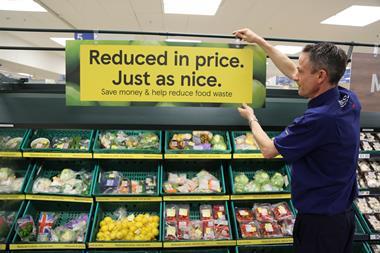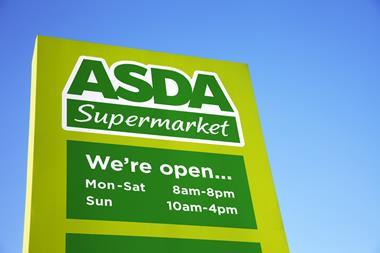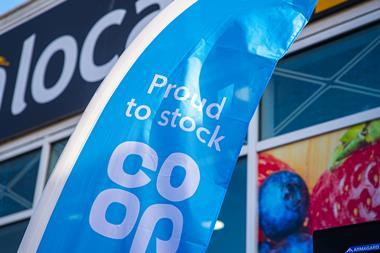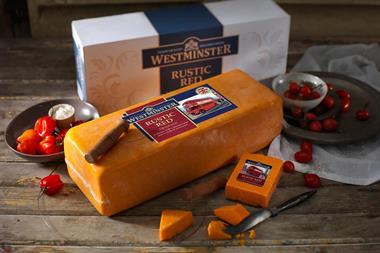As Asda tests instore digital advertising, Sian Harrington asks if supermarkets can work as media owners
On Monday Asda becomes the latest multiple to pilot instore digital advertising - cementing the trend for food retailers to become media owners.
The UK’s second largest grocery retailer is following in the footsteps of Tesco and Spar, both of which have signalled their commitment to this new advertising medium. Tesco is expanding its network to 300 stores by the end of the year, while Spar has plans for a phase two test in 100 stores before deciding on a roll-out.
Asda media centre director Sarah Brookfield says the plasma screen network trial taking place in its Wembley and York stores is part of a wider strategy to ensure the right advertising message is in the right vehicle across its store estate. But is it such a good idea for retailers to transform themselves into media owners?
On the face of it, there is plenty of evidence to support retailers’ case. TV advertising spend is flat, with audiences increasingly hard to reach thanks to the proliferation of channels. But food retailers reach tens of millions of customers each week and research shows that more than 70% of buying decisions are made instore.
Research by independent outdoor specialist Concord estimates that third-party spend on retail media will be £50m for 2004. This figure excludes monies spent as part of a supplier’s trade deal, representing instead investment in media space - including six-sheet posters, trolley advertising, floor graphics and instore screens. This investment has nearly doubled since 2001 (see retail media spend box far right).
Asda is confident. Earlier this year it set up a one-stop shop bringing its 14 media opportunities together (see page 34). The Asda media centre is outsourced to advertising agency Publicis and, according to Brookfield, is an independent body sitting between Asda and media owners, providing objective advice.
“For Asda it is not about driving profit, it is about driving sales by getting people to use the media opportunities we can offer,” says Brookfield. “We are taking a long-term view.”
But behind the hype all is not as rosy as the retailers’ PR machines would lead us to believe. This is particularly evident when it comes to instore digital advertising - a useful barometer as it is being positioned as a way of tapping into suppliers’ general media budgets.
Tesco stresses that its Tesco TV is about improving the customer’s shopping experience. Media and revenue generation manager Bill Pennell says: “Tesco is always driving to maximise customer experience in the store. With this solution we provide more information to our customers directly at the point of sale and can add real value to their shopping experience.” Yet, as Pennell’s title reveals, the medium is being run out of Tesco’s revenue-generating division, which has been established to develop money-making ideas that do not dip into suppliers’ traditional trade marketing budgets. Tesco’s media sales provider, JCDecaux, has declared that it wants to take 1% of brands’ TV advertising budgets, equating to roughly £100m over five years.
But advertising agencies are still struggling to understand the proposition. “Tesco TV is powerful, but agencies are not geared up to deal with individual networks. They don’t understand what they are buying and find it difficult to compare rate cards,” says Martin Kingdon, director general of point of purchasing association POPAI UK.
If you can’t convince the agencies then the answer is to go directly to the clients - and this is precisely what Tesco, Spar and Asda are doing.
Sainsbury, on the other hand, appears to have given up on the idea for the foreseeable future. It ran an eight-week digital trial of shelf-edge small screens and hanging plasmas last year. A spokeswoman says: “We have taken many lessons from it but at present we have no immediate plans to use the technology in our stores. We are constantly monitoring the situation and will continue to look into the best ways of communicating with our customers.”
The problem for all these retailers is that suppliers have yet to be convinced. One major brand owner is testing content and conducting its own research in Tesco as it seeks evidence to back up the impressive sales uplift figures being released by the retailer. And in some cases suppliers find traditional promotional investment is refused as retailers try to get them to channel this support into digital advertising.
The key issue is whether sales uplifts are being driven solely by digital advertising or are the result of the sales promotion offered at the shelf. To test the effectiveness of the new medium there should be a comparison to control stores where the sales promotion is offered on its own, where it is on screen only and where there are both.
“This would provide all parties with sufficient information on the best way to invest sales support money,” says one supplier. “At the moment, it appears suppliers are encouraged to invest in this new mechanic before being presented with sufficient sales information on effectiveness.”
This doesn’t mean that dreams of raising significant additional revenues by positioning your store estate as a media channel are destined to fail. Despite some concerns, both suppliers and agencies agree that it does make sense for retailers to pursue such strategies.
Procter & Gamble’s director of customer business development, Gary Coombe, says: “Shopper marketing media is becoming more and more important and we do see retailers as the emerging media owners. The reality is that in store environments you have the opportunity to talk to consumers.”
Nick Widdowson, merchandising manager at Unilever Bestfoods, agrees. “Retailer media centres are a great development. It makes complete sense to have a co-ordinated approach to selling instore media. From the perspective of a large supplier, the key advantages lie principally in terms of project management and evaluation.
“Having a single point of contact helps ensure consistency, making it easier to project-manage by providing clear accountability and increasing the speed and consistency of decision-making, which can be a stumbling block in a big organisation.”
Peter Knowland, client services director and head of new business at advertising agency Abbott Mead Vickers BBDO, says: “New ideas like Tesco TV and Asda FM are logical extensions of customer magazines.”
So, if there is a consensus that retailers are pursuing the correct path, what is hindering progress? Simon Bolton, chief executive of JWT London, believes that, in the case of instore digital networks, the proposition is built too much around the retailer’s interest rather than what the consumer, and brands, require. But he concedes: “It is a fledgling medium but an important fledgling medium. Anything coming from these two retail brands - Tesco and Asda - is worth looking at seriously.”
POPAI’s Kingdon says it all depends on whether supermarkets are doing it for the ‘right’ reasons. “I think it is a good idea for supermarkets to do this if they can genuinely control all their media. The caveats are that they can exercise control over the buying teams and other parties interested in the instore environment so that they actually deliver what they are selling.
“The right reasons are based around taking a responsible approach to brand, category and overall store; and having clear guidelines on what is and is not acceptable.”
He points out that it should help retailers control non-approved material. “This may mean a rethink as to how they deal with instore merchandisers from third party companies, and a programme of education to store managers to show bottom-line results from integrating instore media.”
So the view is that, if supermarkets approach it the correct way, they will be an important media channel in the future.
As JWT’s Bolton says: “Some recalibration is needed. If you ask whether instore screen media is taken seriously now the answer is no. Will it be in three years? You bet.”
Opportunities >>Asda media’s Key opportunities
1 Instore plasma screens
2 What’s New in Asda leaflets
3 Asda.com
4 Special supplements
5 Trolleys
6 Asda magazine
7 Events
8 Posters
Other key opportunities offered by Asda’s media are: supplier-funded radio, press, co-branded TV ads, statements for storecard, Asda FM instore radio, petrol pumps, sampling.
Retail media spend >>2001-2004 (excl trade marketing)
2001 £26.8m
2002 £34.4m
2003 £42.0m
2004 £50.0m (estimate)
Source: Concord
On Monday Asda becomes the latest multiple to pilot instore digital advertising - cementing the trend for food retailers to become media owners.
The UK’s second largest grocery retailer is following in the footsteps of Tesco and Spar, both of which have signalled their commitment to this new advertising medium. Tesco is expanding its network to 300 stores by the end of the year, while Spar has plans for a phase two test in 100 stores before deciding on a roll-out.
Asda media centre director Sarah Brookfield says the plasma screen network trial taking place in its Wembley and York stores is part of a wider strategy to ensure the right advertising message is in the right vehicle across its store estate. But is it such a good idea for retailers to transform themselves into media owners?
On the face of it, there is plenty of evidence to support retailers’ case. TV advertising spend is flat, with audiences increasingly hard to reach thanks to the proliferation of channels. But food retailers reach tens of millions of customers each week and research shows that more than 70% of buying decisions are made instore.
Research by independent outdoor specialist Concord estimates that third-party spend on retail media will be £50m for 2004. This figure excludes monies spent as part of a supplier’s trade deal, representing instead investment in media space - including six-sheet posters, trolley advertising, floor graphics and instore screens. This investment has nearly doubled since 2001 (see retail media spend box far right).
Asda is confident. Earlier this year it set up a one-stop shop bringing its 14 media opportunities together (see page 34). The Asda media centre is outsourced to advertising agency Publicis and, according to Brookfield, is an independent body sitting between Asda and media owners, providing objective advice.
“For Asda it is not about driving profit, it is about driving sales by getting people to use the media opportunities we can offer,” says Brookfield. “We are taking a long-term view.”
But behind the hype all is not as rosy as the retailers’ PR machines would lead us to believe. This is particularly evident when it comes to instore digital advertising - a useful barometer as it is being positioned as a way of tapping into suppliers’ general media budgets.
Tesco stresses that its Tesco TV is about improving the customer’s shopping experience. Media and revenue generation manager Bill Pennell says: “Tesco is always driving to maximise customer experience in the store. With this solution we provide more information to our customers directly at the point of sale and can add real value to their shopping experience.” Yet, as Pennell’s title reveals, the medium is being run out of Tesco’s revenue-generating division, which has been established to develop money-making ideas that do not dip into suppliers’ traditional trade marketing budgets. Tesco’s media sales provider, JCDecaux, has declared that it wants to take 1% of brands’ TV advertising budgets, equating to roughly £100m over five years.
But advertising agencies are still struggling to understand the proposition. “Tesco TV is powerful, but agencies are not geared up to deal with individual networks. They don’t understand what they are buying and find it difficult to compare rate cards,” says Martin Kingdon, director general of point of purchasing association POPAI UK.
If you can’t convince the agencies then the answer is to go directly to the clients - and this is precisely what Tesco, Spar and Asda are doing.
Sainsbury, on the other hand, appears to have given up on the idea for the foreseeable future. It ran an eight-week digital trial of shelf-edge small screens and hanging plasmas last year. A spokeswoman says: “We have taken many lessons from it but at present we have no immediate plans to use the technology in our stores. We are constantly monitoring the situation and will continue to look into the best ways of communicating with our customers.”
The problem for all these retailers is that suppliers have yet to be convinced. One major brand owner is testing content and conducting its own research in Tesco as it seeks evidence to back up the impressive sales uplift figures being released by the retailer. And in some cases suppliers find traditional promotional investment is refused as retailers try to get them to channel this support into digital advertising.
The key issue is whether sales uplifts are being driven solely by digital advertising or are the result of the sales promotion offered at the shelf. To test the effectiveness of the new medium there should be a comparison to control stores where the sales promotion is offered on its own, where it is on screen only and where there are both.
“This would provide all parties with sufficient information on the best way to invest sales support money,” says one supplier. “At the moment, it appears suppliers are encouraged to invest in this new mechanic before being presented with sufficient sales information on effectiveness.”
This doesn’t mean that dreams of raising significant additional revenues by positioning your store estate as a media channel are destined to fail. Despite some concerns, both suppliers and agencies agree that it does make sense for retailers to pursue such strategies.
Procter & Gamble’s director of customer business development, Gary Coombe, says: “Shopper marketing media is becoming more and more important and we do see retailers as the emerging media owners. The reality is that in store environments you have the opportunity to talk to consumers.”
Nick Widdowson, merchandising manager at Unilever Bestfoods, agrees. “Retailer media centres are a great development. It makes complete sense to have a co-ordinated approach to selling instore media. From the perspective of a large supplier, the key advantages lie principally in terms of project management and evaluation.
“Having a single point of contact helps ensure consistency, making it easier to project-manage by providing clear accountability and increasing the speed and consistency of decision-making, which can be a stumbling block in a big organisation.”
Peter Knowland, client services director and head of new business at advertising agency Abbott Mead Vickers BBDO, says: “New ideas like Tesco TV and Asda FM are logical extensions of customer magazines.”
So, if there is a consensus that retailers are pursuing the correct path, what is hindering progress? Simon Bolton, chief executive of JWT London, believes that, in the case of instore digital networks, the proposition is built too much around the retailer’s interest rather than what the consumer, and brands, require. But he concedes: “It is a fledgling medium but an important fledgling medium. Anything coming from these two retail brands - Tesco and Asda - is worth looking at seriously.”
POPAI’s Kingdon says it all depends on whether supermarkets are doing it for the ‘right’ reasons. “I think it is a good idea for supermarkets to do this if they can genuinely control all their media. The caveats are that they can exercise control over the buying teams and other parties interested in the instore environment so that they actually deliver what they are selling.
“The right reasons are based around taking a responsible approach to brand, category and overall store; and having clear guidelines on what is and is not acceptable.”
He points out that it should help retailers control non-approved material. “This may mean a rethink as to how they deal with instore merchandisers from third party companies, and a programme of education to store managers to show bottom-line results from integrating instore media.”
So the view is that, if supermarkets approach it the correct way, they will be an important media channel in the future.
As JWT’s Bolton says: “Some recalibration is needed. If you ask whether instore screen media is taken seriously now the answer is no. Will it be in three years? You bet.”
Opportunities >>Asda media’s Key opportunities
1 Instore plasma screens
2 What’s New in Asda leaflets
3 Asda.com
4 Special supplements
5 Trolleys
6 Asda magazine
7 Events
8 Posters
Other key opportunities offered by Asda’s media are: supplier-funded radio, press, co-branded TV ads, statements for storecard, Asda FM instore radio, petrol pumps, sampling.
Retail media spend >>2001-2004 (excl trade marketing)
2001 £26.8m
2002 £34.4m
2003 £42.0m
2004 £50.0m (estimate)
Source: Concord



![XOXO-Product-Shot[ALL FLAVOUR]-Sky-1920x1080](https://dmrqkbkq8el9i.cloudfront.net/Pictures/274x183/4/9/2/355492_xoxoproductshotallflavoursky1920x1080_806584_crop.jpg)







![XOXO-Product-Shot[ALL FLAVOUR]-Sky-1920x1080](https://dmrqkbkq8el9i.cloudfront.net/Pictures/380x253/4/9/2/355492_xoxoproductshotallflavoursky1920x1080_806584_crop.jpg)




No comments yet